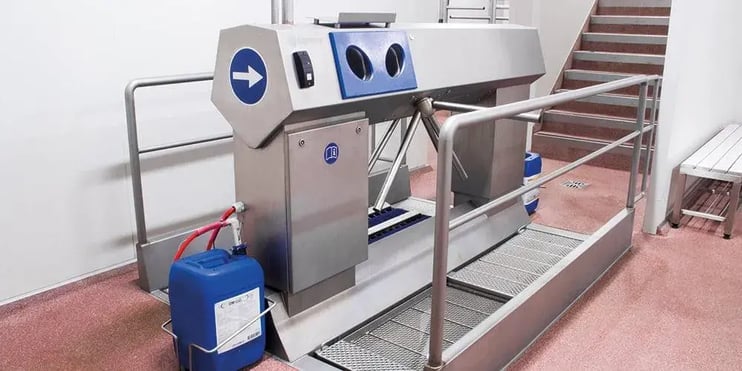Hygienic entrance with sole cleaning: brushes or a disinfection bath?

The soles of shoes carry a lot of visible and invisible dirt. It is therefore important to clean them thoroughly before entering the production area. If an employee wants to enter a so-called ‘high care’ area, then disinfecting the soles is also a must.
Employees who come in wearing outdoor shoes and want to enter a production area where, for example, food is being processed, are obliged to clean their soles. In general, cleaning the soles with brushes is sufficient. In the Elpress hygiene locks, sole cleaning is almost always combined with washing and/or disinfecting the hands. While the employee disinfects his hands, the soles of his shoes are also cleaned. A hygiene sluice with sole cleaning only is also possible, but is much less common in practice.
Rotating brushes in the hygiene sytem
The soles are cleaned with rotating brushes which are automatically activated by means of sensors. The brushes are moistened with water to which a small amount of disinfectant has also been added. This ensures effective disinfection, sufficient room for access to a production area where, for example, meat products are processed. In a hygiene lock, the sole cleaning can also be combined with shoe edge cleaning or - if boots are worn - shaft cleaning.
High level disinfection - Footwear disinfecting bath
If employees want to enter a high care room - for example, a packaging room or the laboratory of a meat processing company - they first need to change their shoes. Everyday shoes therefore never enter such a high care space. Outdoor shoes or boots are placed in a shoe rack, the employee then steps over a bench into the ‘clean’ zone and puts on shoes for the high care area. In order to gain access to the high care area, the employee must go through a disinfection bath. This bath is often part of a hygiene lock where the hands are disinfected at the same time. Only after disinfection is the entrance gate released and the employee can enter the building.
The disinfection bath ensures that invisible microorganisms are also removed and the shoes or boots rendered sterile. The disinfection bath is automatically refreshed after twenty-five passages.
When the employee leaves the high care area again, the soles are cleaned with brushes or a disinfecting bath so that the shoes or boots are clean again and ready to pass through the disinfecting bath again when entering the high care area.
When do you choose a hygiene entrance with brush sole cleaning?
-
Where a general standard of hygiene should be achieved (low care)
-
When there is gross contamination of the footwear
When do you choose a hygiene entrance with a disinfecting bath?
- As a control for entering a high care area
- As an extra hygiene measure after the brush cleaning of the soles
Which hygienic entrance is the best fit for your business?
Do you want to know which layout of the hygiene lock suits your company? Then fill in the Hygiene Selector. In five steps, you can quickly and easily see what your hygiene lock has to comply with. You will then immediately receive no-obligation, customised advice about a hygiene lock for your company.
.webp)




.jpg?width=600&height=300&name=83203100%20-%20DZD-1000-R%20(3.1).jpg)
